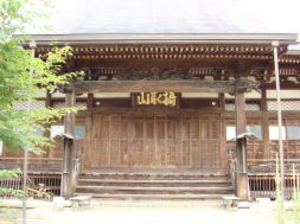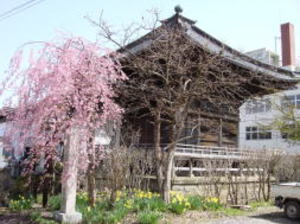Jodo Shinshu Otani sect Sesshuzan Kosho-ji temple
This is an old story about the statue of filial piety Prince Shotoku, heard from my grandmother when I
was childhood.
Once upon a time,
the Prince was in the Komyo-ji temple of the next door. At one night, the Prince is standing in the dream of the
priest and said, " I want to go to over there (Koshoji)". It was not possible to believe at first, and because it had lasted for three days,
the priest gathered every one of the parishioners, and conveyed the word of the Prince Shotoku who had been appear in one’s dream,
" What should I do? " It is
said that it consulted. Surprised to heard the parishioners, "not even !" and "this is not so !"
it is said that it
argued violently. Even so, they said,
"The Prince wants
to go, so we'll leave it in Prince's heart. it is said that the opinion was settled.
Therefore, the Prince says that he is in Kosho-ji temple. This story is, Kyoho 17 year (1732 year, time of Yoshimune Tokugawa and
Ooka-Echizen-no-kami ), and then
Taishido was erected.
The Taishido of the present year was rebuilt in Showa 14 year (1939 year).
In the early time of Showa 30s (about 1955 year), the statue of Prince Shotoku was in Taishido, and on the day of the Taishi-Ko,
Taishido was decorated with gorgeous artificial flowers, and the Association people behaved sweets and screened films to childrens in
the neighborhood. The Prince is now in
Main Hall.
In the old time of Aizu Bange area, the Prince’s faith is flourishing, and the Taishi-Ko was a grand celebrated until the Showa 30s’.
The sculpture of the transom of Taishido is the one that the ambition of Prince Shotoku was expressed, and it is a work of the sculptor
Ukon Watanabe of the Nihonmatsu-born master craftsman. His wife
was from the Kitoku-ji temple in Chaya-machi.
A Western-style sculpture inside the Parliament building is a work of Watanabe.
The photo is the
Taishi-do in Hockai-Ji temple
In pedestrianized of the Town Hall is located, next door of west of Komyo-ji temple. The street of Town Hall west (old time called, the
Magistrate street) is about 20 m to front of the gate.
In Shinpen-Aizu-Fudoki, "Kosho-ji temple, in Chaya-machi, Kan-ei 1 year(1624 year, the age of Tokugawa Iemitsu, the Katsura Rikyu,
and the Yomeimon Gate of Nikko Toshogu were finished) foundation, Shinshu branch temple of Kyoto Honganji temple, the principal
Buddha is AmidaBuddha, enshrined in Kyakuden.
In the Temple biography,Yashu(Tochigi prefecture) the Lord of castle Wada
Zaemon Shigemori, the eldest son Kosho was fallen to Shinshu(Nagano prefecture) in
priest, named Genmyo.
He was founded Wada-zan Genmyo-ji temple. Eisho15 year (1518 year,Muromachi period, time of the rise of Sengoku-daimyo) second
son Zenmyo was founded in Echigo Takada (Takada city, NiigataPrefecture) Wada-zan Kosho-ji temple.
The second Ganmyo, Eiroku 2 year (1559 year, Nobunaga Oda, be at the helm of the whole world), and moved to Wakamatsu with the
invitation of Aizu Lord Ashina. Kansei 2 year (1625 year) the fifthgeneration Gansei has been opened to the present position, and
has renewed named Sesshuzan Kosho-ji temple and has been to the present. The temple gate is have been conveyed to
had been
relocated from the Komyo-ji next
to the east. The main hall of the present year was rebuilt in Showa 12 year (1937 year).
This temple’s "Kenpon Chakushoku Komyo Honzon" is designated as an important cultural property of the prefecture.
Made in the late Kamakura period, as the Komyo principal image, it is the one that has been told to be the oldest Japan.
From the gold character of the central "Kimyo Jin Jippo Mugeko Nyorai", in the light that emits, the founder imageof
the Chinese, to
the right, Prince Shotoku, Umako Soga, Ono-no Imoko,
Genshin, Honen and Shinran etc. eight founder image statues are depicted.
India, China, is a uniquemandala- style painting depicting the genealogy of founder image in the Pure Land of Japan.
The souvenir of the nether, it is a gem of the national treasure class which should be
a see it once.
"Kimyo" is a Sanskrit language
that says, " I give body life of the self and to be converted to Buddha".
"Jin Jippo Mugeko Nyorai" it
is "Amida Buddha". It is said that the Enlightenment of Amida-like light is universally the whole world, and there is nothing to
prevent. In plain terms, "the blessings of Amida are prevailing in every corner of the world. It is to say.
Location : Chaya-machi, Aizu Bange town.
Prior permission is necessary for the visit in the main hall.
Please contact the Aizu Bange town Tourism Product Association (℡ 0242-83-2111) in advance.
(Welcome map Aizu Bange town Central area map)
Moving the Prince
Shotoku


